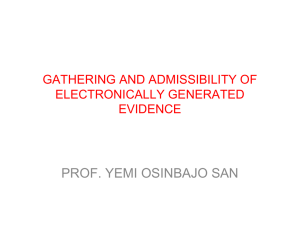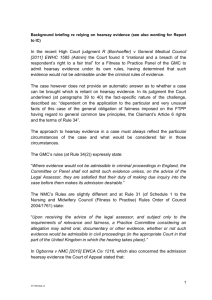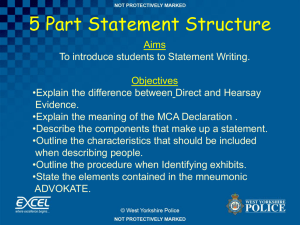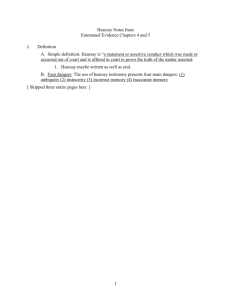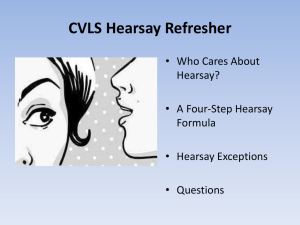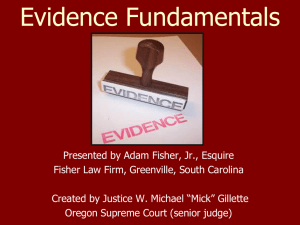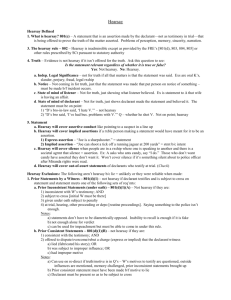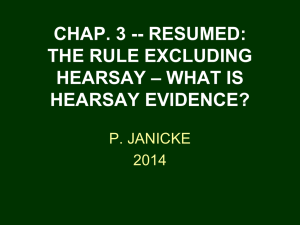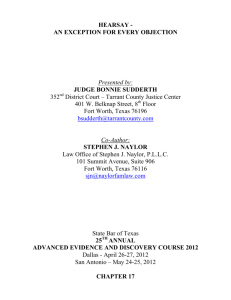Hearsay Issues in Surrogate's Court Proceedings
advertisement
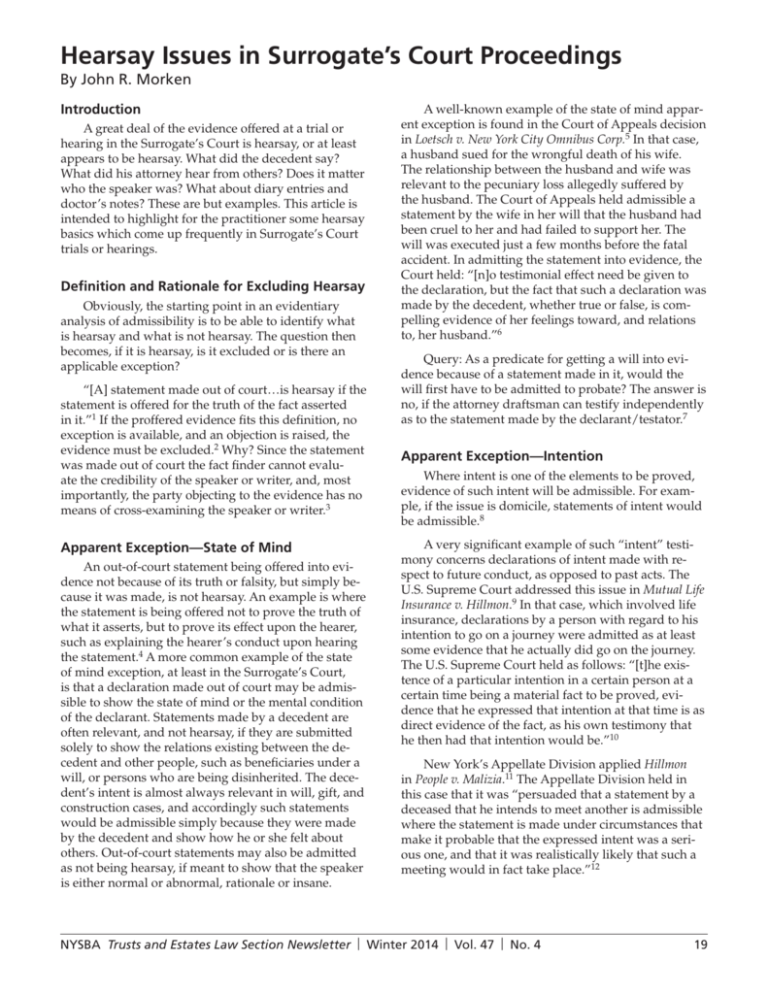
Hearsay Issues in Surrogate’s Court Proceedings By John R. Morken Introduction A great deal of the evidence offered at a trial or hearing in the Surrogate’s Court is hearsay, or at least appears to be hearsay. What did the decedent say? What did his attorney hear from others? Does it matter who the speaker was? What about diary entries and doctor’s notes? These are but examples. This article is intended to highlight for the practitioner some hearsay basics which come up frequently in Surrogate’s Court trials or hearings. Definition and Rationale for Excluding Hearsay Obviously, the starting point in an evidentiary analysis of admissibility is to be able to identify what is hearsay and what is not hearsay. The question then becomes, if it is hearsay, is it excluded or is there an applicable exception? “[A] statement made out of court…is hearsay if the statement is offered for the truth of the fact asserted in it.”1 If the proffered evidence fits this definition, no exception is available, and an objection is raised, the evidence must be excluded.2 Why? Since the statement was made out of court the fact finder cannot evaluate the credibility of the speaker or writer, and, most importantly, the party objecting to the evidence has no means of cross-examining the speaker or writer.3 Apparent Exception—State of Mind An out-of-court statement being offered into evidence not because of its truth or falsity, but simply because it was made, is not hearsay. An example is where the statement is being offered not to prove the truth of what it asserts, but to prove its effect upon the hearer, such as explaining the hearer’s conduct upon hearing the statement.4 A more common example of the state of mind exception, at least in the Surrogate’s Court, is that a declaration made out of court may be admissible to show the state of mind or the mental condition of the declarant. Statements made by a decedent are often relevant, and not hearsay, if they are submitted solely to show the relations existing between the decedent and other people, such as beneficiaries under a will, or persons who are being disinherited. The decedent’s intent is almost always relevant in will, gift, and construction cases, and accordingly such statements would be admissible simply because they were made by the decedent and show how he or she felt about others. Out-of-court statements may also be admitted as not being hearsay, if meant to show that the speaker is either normal or abnormal, rationale or insane. A well-known example of the state of mind apparent exception is found in the Court of Appeals decision in Loetsch v. New York City Omnibus Corp.5 In that case, a husband sued for the wrongful death of his wife. The relationship between the husband and wife was relevant to the pecuniary loss allegedly suffered by the husband. The Court of Appeals held admissible a statement by the wife in her will that the husband had been cruel to her and had failed to support her. The will was executed just a few months before the fatal accident. In admitting the statement into evidence, the Court held: “[n]o testimonial effect need be given to the declaration, but the fact that such a declaration was made by the decedent, whether true or false, is compelling evidence of her feelings toward, and relations to, her husband.”6 Query: As a predicate for getting a will into evidence because of a statement made in it, would the will first have to be admitted to probate? The answer is no, if the attorney draftsman can testify independently as to the statement made by the declarant/testator.7 Apparent Exception—Intention Where intent is one of the elements to be proved, evidence of such intent will be admissible. For example, if the issue is domicile, statements of intent would be admissible.8 A very significant example of such “intent” testimony concerns declarations of intent made with respect to future conduct, as opposed to past acts. The U.S. Supreme Court addressed this issue in Mutual Life Insurance v. Hillmon.9 In that case, which involved life insurance, declarations by a person with regard to his intention to go on a journey were admitted as at least some evidence that he actually did go on the journey. The U.S. Supreme Court held as follows: “[t]he existence of a particular intention in a certain person at a certain time being a material fact to be proved, evidence that he expressed that intention at that time is as direct evidence of the fact, as his own testimony that he then had that intention would be.”10 New York’s Appellate Division applied Hillmon in People v. Malizia.11 The Appellate Division held in this case that it was “persuaded that a statement by a deceased that he intends to meet another is admissible where the statement is made under circumstances that make it probable that the expressed intent was a serious one, and that it was realistically likely that such a meeting would in fact take place.”12 NYSBA Trusts and Estates Law Section Newsletter | Winter 2014 | Vol. 47 | No. 4 19 On the other hand, the U.S. Supreme Court has referred to its holding in Hillmon as “the high waterline beyond which courts have been unwilling to go.”13 Thus, a declaration of a presently existing state of mind is not admissible to prove a past act, as opposed to future conduct.14 The issue of intent is key in abandonment cases. The burden of proof is on the party asserting abandonment, which will usually require a showing that there was no consent or acquiescence in the separation between the spouses. As the Nassau Surrogate held in one abandonment case, In re Reisman,15 “proof that she (the decedent) did not consent necessarily implicates her state of mind at or around the time of separation and thereafter. Generally, the mere utterance of a statement, without regard to its truth, may indicate circumstantially the state of mind of the declarant (cites omitted).”16 Significantly, the Court in Reisman went on to state: “[b]ecause human relations between spouses are so complex and separations often occur with or without consent and the burden on a petitioner to show lack of consent is often frustrated by the absence of the decedent, wide latitude should be given in accepting this evidence of state of mind.”17 The Court allowed certain testimony as to what the decedent had said about her husband because such evidence was relevant on the issue of consent and, in fact, demonstrated that “she would go back to him in a heartbeat if he would let her.” The Court in Reisman distinguished the decision in In re Campbell.18 In Campbell, the Surrogate had held that certain testimony as to statements made by the decedent “were pure hearsay and not receivable,” because such evidence was “tendered on the theory that the declarations of deceased, if received, would establish that the separation was without fault on his part and that it was due to a willful disregard of her marital obligations by the surviving spouse.”19 In Reisman, similar statements were not tendered to show whether the separation was justified or unjustified, but rather solely on whether the decedent had consented to the separation. The evidence was admissible since it solely went to her intent. The different holdings in Campbell and Reisman illustrate how it is necessary clearly to articulate the basis for such testimony as solely being relevant to intent. Apparent Exception—Res Gestae Literally res gestae means “the thing done.”20 Generally, what is meant by this concept is that with the act or conduct being described, declarations made simultaneously may be admissible as explaining the act itself. (It should be noted that the use of the phrase “res gestae” has been severely criticized, as not adding anything to hearsay analysis).21 Three examples which 20 come up frequently in Surrogate’s Court litigation, illustrating what may be called res gestae, are with regard to the execution of a will, revocation of a will, and statements associated with gifts. Physical destruction of a will alone does not constitute a revocation. There must be an intent to revoke which accompanies the destruction. Consequently, a person’s statements of intent which accompany the act of destruction would be admissible.22 Similarly, in a gift case where intent is one of the elements, a declaration of intent which accompanies the delivery would be admissible to show that the gift is indeed a gift.23 In a probate proceeding, declarations of the testator during the will execution ceremony are admissible to satisfy the statutory publication requirement.24 Publication requires a declaration by words or some other sign by the testator that it is his will, and that he wants the witnesses to witness it.25 The declarations of the testator at the time of signing the will are part of the act itself and are admissible to show publication.26 In effect, a meeting of the minds between the testator and the attesting witnesses is evidenced by the declarations of the testator to the witnesses and the conduct of the witnesses in signing the will.27 Additionally, besides proving publication, statements made by a testator at or about the time of the execution may be admissible for the sole purposes of evidencing the testator’s state of mind at the time of the execution.28 An example of this is illustrated in the well-known case of Matter of Putnam.29 There, the Court of Appeals stated that the testator’s “statements are not evidence of the facts to which they may relate. They would not be, for instance, evidence of what the lawyer did or said at the time of the making of the will or on any other occasion. Her statements, however, both before and after the making of the will, would be competent to show the state of her mind, her mental capacity, her attitude and feeling toward her lawyer, and her ability to resist his influence.”30 Lost Wills Proving a lost will is of course very difficult. SCPA 1407 provides that a lost or destroyed will may only be admitted to probate if: (i) It is established that the will has not been revoked, and (ii) Execution of the will is proved in the manner required for the probate of an existing will, and (iii) All the provisions of the will are clearly and distinctly proved by each of at least two creditable witnesses or by a copy or draft of the will proved to be true and complete. NYSBA Trusts and Estates Law Section Newsletter | Winter 2014 | Vol. 47 | No. 4 Declarations of the testator are not admissible for the purpose of proving the contents of a lost or destroyed will. Additionally, declarations of the testator are inadmissible to prove non-revocation, and thus to establish the existence of the will at the time of death.31 The Court of Appeals has held that oral statements of the testator that he had mistakenly destroyed his will about a year before he died was inadmissible hearsay.32 against interest when made. Declarations against interest, on the other hand, are admissible whether the declarant is a party or not a party. A declaration against interest is an out-of-court statement which was against the declarant’s interest at the time of its making, and is admissible because it is surmised that people do not usually make statements that are against their personal interest, and such statements therefore are more likely to be reliable than not.38 Exceptions—Pedigree It is also important to distinguish admissions from prior inconsistent statements. The latter is used to impeach the credibility of the witness, and not for proof of the statements contained therein.39 Statements of personal history, where the declarant is unavailable, may be admissible. Thus, in Matter of Tumpeer,33 in attempting to establish her status as a niece of the decedent, an alleged distributee testified as to a conversation she had had with her mother about her family history. The alleged distributee’s mother claimed that her sister, allegedly the decedent, had changed her maiden name in order to deceive her husband into believing she was Jewish, and thus had a different maiden name than the alleged distributee. The court held that the testimony could be admitted under the pedigree exception to the hearsay rule. The evidence satisfied the following requirements: the declarant was not available to testify (either as a result of death or other cause), pedigree was directly an issue, the declarant was related by blood or affinity to the family affected by the declaration, the declarations were made before the controversy arose, and there was at least some evidence to corroborate the statement. Similarly, in a contested probate action, a contestant may be able to utilize the pedigree exception to establish that he is indeed a distributee of the decedent.34 Exceptions—Admissions, Declarations Against Interest and Prior Inconsistent Statements Any out-of-court statement made by a party which is inconsistent with his position at trial may be given in evidence as an admission. As a hearsay exception, it is received as evidence of the fact admitted.35 An interesting exception to the general rule concerning admissions comes up in certain probate cases. If a will has only one legatee, then an admission by him will be competent evidence. On the other hand, there is a general rule that an admission by one party in interest cannot be admitted against another party of interest. That rule results in the evidence being excluded entirely, because it would be impossible to admit the will as to one legatee, but to reject it as to another.36 Out-of-court statements made by administrators and executors are admissible against the estate, if made while acting in their official capacity.37 It is important to distinguish admissions from declarations against interest. An admission need not be Exception—Business Records CPLR 4518 governs business records. It is important that any practitioner in the Surrogate’s Court be familiar with this section. In order for a document to be admissible as a business record, the following four foundation elements must first be shown: “that it was made in the regular course of any business and that it was the regular course of such business to make it, at the time of the act, transaction, occurrence or event, or within a reasonable time thereafter.”40 Additionally, the person who made the record must have had actual knowledge of the recorded event or received his information from someone with actual knowledge who had a business duty to report the same.41 The term business “includes a business, profession, occupation, and calling of every kind.”42 Accordingly, personal private records and documents cannot be admitted in evidence based upon CPLR 4518. Private memoranda not made as part of a business, such as a personal check register, may not satisfy the requirement.43 Hospital records provide a significant instance of records coming under the business record exception.44 To be admissible, they must bear a certification or authentication by the head of the hospital.45 However, to satisfy the exception, such records must “relate to the condition or treatment of a patient.”46 Thus, in any given instance, the hospital records should be carefully studied to make sure that extraneous materials, not related to the condition or treatment of the patient, are excluded. Careful scrutiny should be given to any document, whether a hospital record or business record, to ensure that it does not contain double hearsay. Double hearsay statements are declarations made within a document which are based upon statements made to the recorder by someone else. That portion of the document will be excised by the court, unless it is shown to the court’s satisfaction that it was obtained from someone whose statement itself satisfies a hearsay exception. NYSBA Trusts and Estates Law Section Newsletter | Winter 2014 | Vol. 47 | No. 4 21 Exception—Prior Testimony Prior testimony may be admitted under certain circumstances, whether it be from a deposition47 or from a prior trial.48 Three conditions set forth for the admission of former testimony at a trial are: (i) unavailability of the witness; (ii) identity of the subject matter; and (iii) identity of the parties.49 Of course, such testimony can also be used for impeachment purposes. Exception—Excited Utterance “One of the better-known exceptions to the injunction against the reception of hearsay testimony permits the introduction of a spontaneous declaration or excited utterance—made contemporaneously or immediately after a startling event—which asserts the circumstances of that occasion as observed by the declarant.”50 Since the person making the statement is generally not available for cross-examination, admissibility of a statement under this exception pushes the boundary, as it were, of the hearsay rule. Accordingly, the court has to carefully assess all the facts and circumstances. In making the determination (of admissibility), the court must ascertain whether, at the time the utterance was made, the declarant was under the stress of excitement caused by an external event sufficient to still his reflective faculties, thereby preventing opportunity for deliberation which might lead the declarant to be untruthful. The court must assess not only the nature of the startling event and the amount of time which has elapsed between the occurrence and the statement, but also the activities of the declarant in the interim to ascertain if there was significant opportunity to deviate from the truth. Above all, the decisive factor is whether the surrounding circumstances reasonably justify the conclusion that the remarks were not made under the impetus of the studied reflection.51 That judges may differ in assessing whether such testimony is admissible is illustrated in comparing the majority decision versus the dissent in People v. Simpson.52 “other evidence,” and its admission “will best serve the purposes of these rules and the interests of justice.”54 While at times it appears that courts seem to apply the Residual Exception in allowing what is otherwise hearsay evidence, New York has refused to follow the Residual Exception.55 The reason for New York’s divergence is obvious: liberally applied, the exception would swallow the rule. The right of counsel to cross-examine, which underlies the refusal of the courts to allow hearsay, will have given away to the court’s determination as to what is reliable.56 Endnotes 1. Farrell, Prince, Richardson on Evidence, § 8-101 (11th ed.). 2. The conduct of a person, albeit non-verbal, may itself be hearsay if it is intended to communicate a statement. An obvious example is sign language. Another is a nod or shake of the head. 3. Richardson, supra at n.1, § 8-102. 4. People v. Felder, 37 N.Y.2d 779, 375 N.Y.S.2d 98 (1975); see generally, Younger, Hearsay: A Practical Guide through the Thicket, § 1.5 (1988). 5. 291 N.Y. 308, 52 N.E.2d 448 (1943). 6. Id. at 311. 7. See e.g., In re Arrathoon, N.Y.L.J., Oct. 22, 2007, p.31, col. 5 (Sur. Ct., N.Y. Co.). 8. In re Newcomb, 192 N.Y. 238, 84 N.E. 950 (1908). 9. 145 U.S. 285 (1892). 10. Id. at 295. 11. 92 A.D.2d 154, 460 N.Y.S.2d 23 (2d Dep’t 1983), aff’d, 62 N.Y.2d 775, 476 N.Y.S.2d 825, 465 N.E.2d 364 (1984), cert denied, 469 U.S. 932 (1984). 12. Id. at 160. 13. Shepard v. U.S., 290 U.S. 96, 105, 54 S.Ct. 22 (1933). 14. See generally, Younger, supra at n.4, § 5.8. 15. In re Reisman, N.Y.L.J. Feb. 8, 2000, p. 33, col. 3 (Sur. Ct., Nassau Co.). 16. Id. 17. Id. 18. 186 Misc. 842, 65 N.Y.S.2d 164 (Sur. Ct., N.Y. Co. 1946). 19. Id. at 843. 20. Richardson, supra at n.1, § 8-601. 21. See Younger, supra at n.4, § 3.9. 22. Waterman v. Whitney, 11 N.Y. 157 (1854). 23. See In re Romano, 8 Misc. 3d 1010(A), 801 N.Y.S.2d 781 (Table) (Sur. Ct., Nassau Co. 2005). 24. Estates, Powers & Trusts Law 3-2.1(a) (EPTL). The Hearsay “Residual Exception” 25. Id. The Federal Rules of Evidence, and in particular Rule 807, set forth the so-called “Residual Exception,” which applies in federal court.53 Rule 807 would allow into evidence, in the court’s discretion, out-of-court statements not specifically covered by a hearsay exception, if that statement is found to have “circumstantial guarantees of trustworthiness,” is not available from 26. See In re Athanasiou, 24 Misc. 2d 12, 202 N.Y.S.2d 675 (Sur. Ct., N.Y. Co. 1960). 27. See N.Y. Pattern Jury Instructions, § 7:45 (N.Y. P.J.I.). 28. Waterman, supra at n.22. 29. 257 N.Y. 140 (1931). 30. Id. at 144. 22 NYSBA Trusts and Estates Law Section Newsletter | Winter 2014 | Vol. 47 | No. 4 31. Richardson, supra at n.1, § 8-613. 44. CPLR 4518(c). 32. See In re Bonner, 17 N.Y.2d 9, 266 N.Y.S.2d 971 (1966); see also In re Kennedy, 167 N.Y. 163, 60 N.E. 442 (1901). 45. See id. 46. CPLR 2306(a). 33. N.Y.L.J., June 4, 2008, p. 39, col. 4 (Sur. Ct., N.Y. Co. 2008). 47. CPLR 3117. 34. In re Esther T, 86 Misc. 2d 452, 382 N.Y.S.2d 916 (Sur. Ct., Nassau Co. 1976). 48. CPLR 4517. 49. Id. 50. People v. Edwards, 47 N.Y.2d 493, 496-497, 419 N.Y.S.2d, 45 (1979). 51. Id. at 497; see Lagner v. Primary Home Care Services, Inc., 83 A.D.3d 1007, 922 N.Y.S.2d 431 (2d Dep’t 2011). 35. Richardson, supra at n.1, § 8-201. 36. In re Kennedy, supra at n.32. 37. Richardson, supra at n.1, § 8-230. 38. Id. at § 8-203. 39. N.Y. P.J.I. § 1:66. 52. 238 A.D.2d 611, 656 N.Y.S.2d 765 (2d Dep’t 1997). 40. Civil Practice Law & Rules 4518 (CPLR). 53. Federal Rules of Evidence 807. 41. See Johnson v. Lutz, 253 N.Y. 124, 170 N.E. 517 (1930); see also Prado v. Onor Oscar Inc., 44 A.D.2d 604, 353 N.Y.S.2d 789 (2d Dep’t 1974). 54. Id. 55. See People v. Nieves, 67 N.Y.2d 125, 131, 501 N.Y.S.2d 1, 492 N.E.2d 109 (1986); see also People v. Wlasiuk, 32 A.D.3d 674, 821 N.Y.S.2d 285 (3d Dep’t 2006). 56. See Younger, supra n.4, § 6.1 (providing a discussion of the Residual Exception). 42. CPLR 4518(a). 43. In re Lauro, N.Y.L.J., Dec. 26, 2001, p. 1, col. 6 (Sur. Ct., Nassau Co.). The Trusts and Estates Law Section Newsletter is also available online Go to www.nysba. org/TrustsEstates Newsletter to access: • Past Issues (2000-present) of the Trusts and Estates Law Section Newsletter* • Trusts and Estates Law Section Newsletter Searchable Index (2000-present) • Searchable articles from the Trusts and Estates Law Section Newsletter that include links to cites and statutes. This service is provided by Loislaw and is an exclusive Section member benefit* *You must be a Trusts and Estates Law Section member and logged in to access. Need password assistance? Visit our Web site at www.nysba.org/ pwhelp or call (518) 463-3200. NYSBA Trusts and Estates Law Section Newsletter | Winter 2014 | Vol. 47 | No. 4 NE W Y OR K S TAT E B AR A S S OC I AT I O N 23

